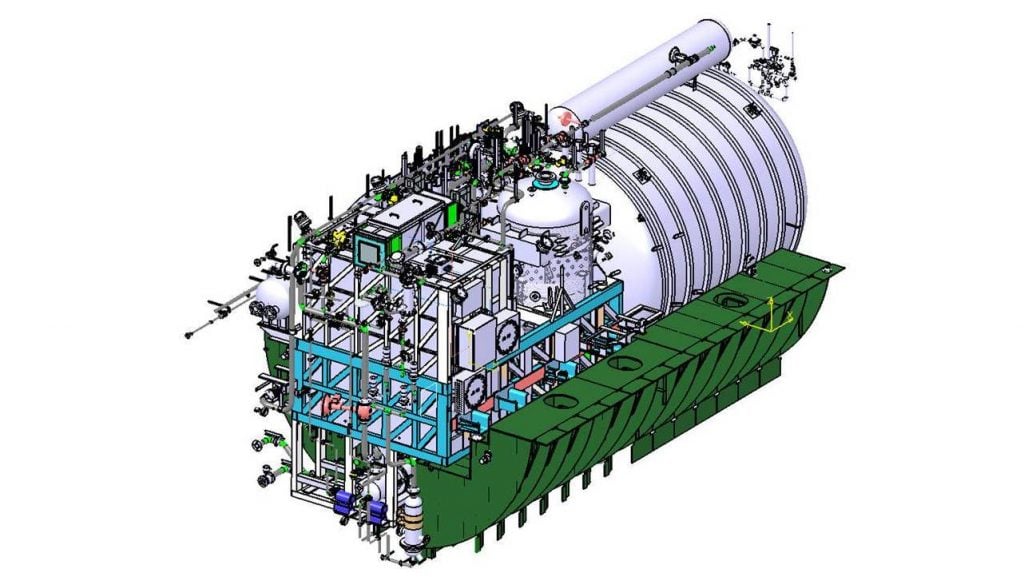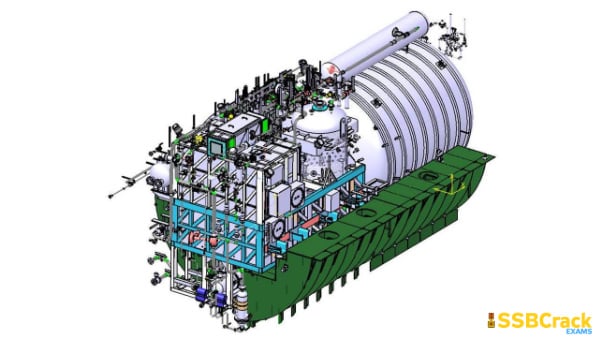The Defence Research and Development Organisation (DRDO) has achieved a crucial milestone when it demonstrated an Air Independent Propulsion (AIP) system earlier this week which will enable Indian Navy submarines to operate for up to two weeks without having to surface to recharge its batteries.

Marking a forward path for the AtmaNirbhar Bharat campaign, these AIP-fitted submarines are much quieter as compared to nuclear-powered submarines, additional benefit being capacity to remain sub-surface for longer duration.
ALSO READ: 32 Achievements Of DRDO In 2020
Earlier on 9 March 2021, the Ministry of Defence announced that “The (AIP) plant was operated in endurance mode and maximum power mode as per the user requirements. The system is being developed by the Naval Materials Research Laboratory (NMRL) of DRDO.”
What is Air Independent Propulsion Technology?
Air-independent propulsion (AIP), or air-independent power, is marine propulsion technology that allows a non-nuclear submarine to operate without access to atmospheric oxygen (by surfacing or using a snorkel). AIP can augment or replace the diesel-electric propulsion system of non-nuclear vessels.
The indigenous AIP propulsion system developed by DRDO is a modular system that can be easily configured for any conventional submarine platform. Currently, the system is configured for P75 submarines which got the safety, interface acceptance and permission from the Submarine designer M/s NG France. The firm soon will undertake the detailed design for its possible integration to the first available P75 platform.
How are AIP-fitted submarines different from the rest?
Legacy diesel-electric submarines operate silently underwater for up to 48 hours, but they have to surface within restricted hours to run a generator that recharges their batteries.
These diesel-electric submarines, when they surface, become vulnerable to detection by enemy radar, which easily detect submarine masts or snorkels jutting on the surface of the water.
This vulnerability can be reduced by powering a submarine with an AIP system, that enables underwater operations for up to two weeks. However, AIP-fitted submarines too surface every fortnight for battery charging. But that still makes them difficult to detect as nuclear-powered subs, which can stay submerged indefinitely.
Fuel cell-based AIP – an even better version of the technology
Fuel cell technology-based AIP generates power through the reverse electrolysis of oxygen and hydrogen. In this process, the two elements chemically combine, thereby generating electricity to charge the submarine’s batteries.
This process does not need air rather it requires the storage of highly inflammable hydrogen on board. This is not true of the DRDO’s AIP system, which relies on the innovative Phosphoric Acid Fuel Cell technology.
Ministry of Defence in a statement had said, “AIP has a force multiplier effect on the lethality of a diesel-electric submarine as it raises the submerged endurance of the boat, several-fold. Fuel cell-based AIP has merits in performance compared to other technologies.”
The process of Phosphoric Acid Fuel Cell technology is more rugged and tolerant of fuel impurities, offering longer life and efficiency.
Moreover, it is much safer, since it does not require hazardous Hydrogen to be stored onboard.
“While there are different types of AIP systems being pursued internationally, fuel cell-based AIP of NMRL is unique as the hydrogen is generated onboard. The technology has been successfully developed (by NMRL), with the support of industry partners Larsen & Toubro and Thermax. It has now reached the stage of maturity for fitment into target vessels,” said the MoD.
“The DRDO-built AIP would be fitted on the Kalvari class submarines during their refit programme. The first refit of the first boat INS Kalvari is scheduled for the year 2023,” French firm Naval Group’s Senior Executive Vice President Alain Guillou told ANI. The French industry official was in India for the biennial DefExpo in Lucknow.
He said the DRDO AIP has been found good and compliant and would add to the capabilities of the submarines. The DRDO has been working with the Navy to develop it at the Naval Materials Research Laboratory (NMRL) in Pune.
The technology has been successfully developed with the support of industry partners L&T and Thermax and has now reached the stage of maturity for fitment into target vessels.
Way-forward with AIP-fitted submarines
The DRDO after successfully testing its AIP on a ‘land-based prototype” (LBP) will now evolve this into a “marinised” AIP system, that can fit into an actual submarine and operate underwater in live conditions.
The other type of AIP in service is currently experimental, known by a French system called “Module d’Energie Sous-Marine Autonome (MESMA). The navy had the option to fit the MESMA AIP systems into the six Scorpene submarines that were contracted in 2005 under Project 75.
Due to certain doubts about MESMA, the navy decided to channel its effort in a conventional diesel-electric system for the Project 75 submarines.
Since the DRDO has developed an indigenous AIP, they will now be fitted onto the Scorpenes submarines which will have a force multiplier effect on the lethality of a diesel-electric submarine as it enhances the submerged endurance of the boat, several folds.
Though NMRL’s is expected to operationally field its indigenous AIP only by 2023-24, this might come too late to power the six new submarines that the navy is tendering in an Rs. 45,000-crore programme called Project 75-I.
Instead, the six Project-75I submarines will be powered by AIP systems that the foreign vendor must offer. The DRDO’s AIP system, once ready, will from 2024-25 onward, be “retrofitted” into six Scorpene submarines that are being built in India under Project 75.
















